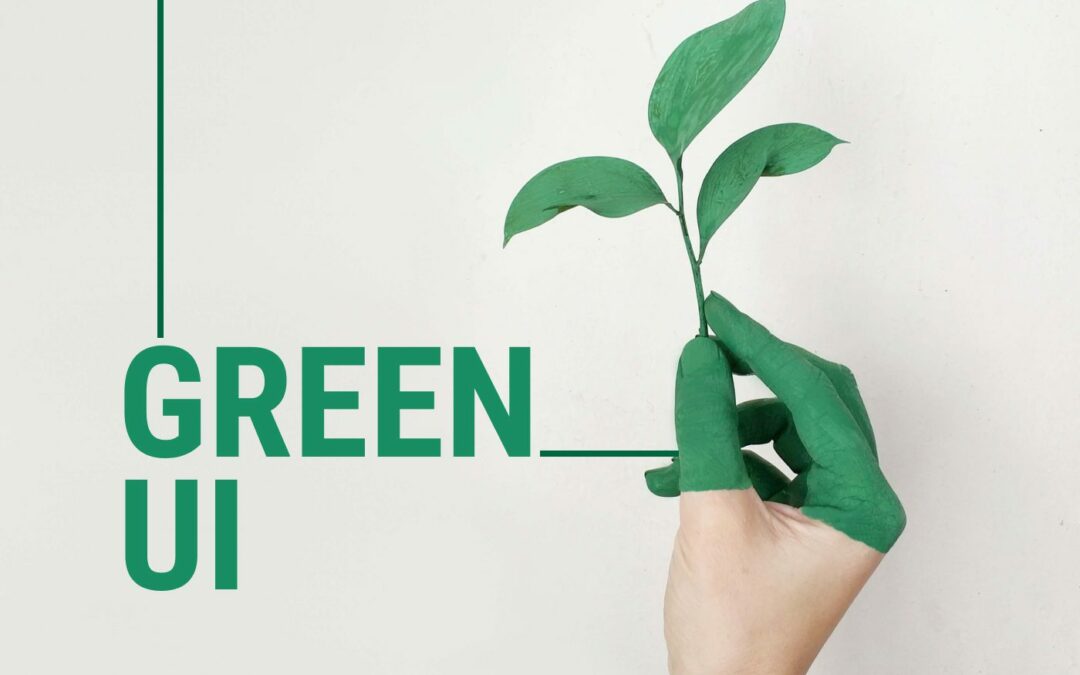Green UI Design and design thinking have never been greener than this.
The grass is perhaps greener on the other side. Not just metaphorically.
Designers are now thinking about how sustainable and eco-friendly their designs are and how they can reduce their carbon footprint. Designing isn’t just about combining forces with technology anymore. It’s also about how technology can propel us into the future without affecting our resources.
But, designing for sustainability isn’t just about reducing our carbon footprint, saving the planet, going green, being eco-friendly, or all these buzzwords.
At the heart of it, it’s about trimming the fat.
Sustainable design goes above and beyond to create solutions that serve a purpose in every click, tap, image, and button. Yet, it should not convey a lack. As a designer, your aim should not be to design just for now; you must design for the future. Staying classic and timeless are just benefits of future-approach designs.
Now, let’s hit you with some stats.
- Each year, the internet contributes to approximately 3.8% of global carbon emissions. Unfortunately, the numbers are only increasing.
- An hour of streaming on Netflix eats up seven GB/hr. This is equal to a carbon footprint of 441 g CO2e/hr. It’s especially alarming as the world collectively spends 164.8 million hours on Netflix each day.
- In a year, the number of emails you send out may emit close to 136 kilograms of CO2e.
- Streaming data through audio and video channels contribute to 63% of the global internet traffic.
- In January 2021, 4.66 billion people worldwide were using the internet – that’s 59.5% of the global population.
So, what are carbon dioxide emissions?
“Carbon dioxide emissions or CO2 emissions are emissions stemming from the burning of fossil fuels.”
What is a carbon footprint?
“A carbon footprint corresponds to the whole amount of greenhouse gases (GHG) produced to, directly and indirectly, support a person’s lifestyle and activities. Carbon footprints are usually measured in equivalent tons of CO2, during the period of a year.”
Sample this:
4.66 billion use the internet every day
350,000 Tweets are sent out in a minute
More than 50% of data centers contain more than 5000 servers
Google rakes in 63000 searches per second
There are 2751 data centers in the US alone
In 2017, Google became 100% powered by renewable energy
By 2025, the IT industry may contribute to 20% of all electricity produced
What does the internet have to do with all of this?
While it may begin with our personal computers and mobile devices, consumption and emissions don’t end there. Apart from these devices, data centers and transmission networks all consume electricity. These, in turn, produce carbon emissions.
When designing for sustainability, one must keep four things in mind:
- Environmental benefits
- Economic progress
- Social change
- And, socio-economic sustenance
We’ll be covering environmental benefits here as carbon emissions — whether that’s merely from breathing and existing or living a lifestyle that requires excessive dependence on technology and its by-products. Global carbon emissions are the number one cause of climate change.
So, as a designer trying to rescue the only planet we have, what can you do?
300 million tonnes of CO2 per year.
That’s the carbon footprint of the internet.
For starters, you can help reduce that number.
According to an article published in A List Apart, Tom Greenwood states that there are two things we can measure as indicators:
- Data transfer
- Carbon intensity of electricity
The more the transfer of data, the more the energy consumption in mobile or stationary devices, telecommunication networks, and ultimately data centers.
Choosing a data center to host your website can be the first green and sustainable design step. Suppose you can find a data center with low carbon energy to host your projects. In that case, you’re going in the right direction to reduce carbon emissions.
However, the data center shouldn’t be on the other side of the world too! The further away from the center, the more energy it requires through the telecom’s network. If the data needs to travel a significant distance to reach you, it’s only spending more energy.
Yet, it’s not just data centers that are the key players here. A user’s browser can contribute to many insights on how designers and developers can orient their projects to make them more earth-friendly. significant leaps in front-end technologies, the load can now be transferred to browsers. So, whether a user opens a browser on his phone, laptop, or any other device, highly developed browsers allow for more complex engagements to be carried out in the browser itself.
But enough about data centers.
Did you know that Google (the mother of everything) is 100% powered by renewable energy?
If the mothership can do it, here’s how you can too.
Of course, if you’re not Google, you’ll have to start small.
Back in 2021, Newsweek went completely digital. It took them 79 years, but hey, they still got there. But, is going paperless enough?
How to Build a Green Website
Go green
You can start by taking the word literally, too.
A green website is a happy website. The human eye can see green better than any other color. It’s nature reminding us to go back to our roots, but mostly it’s science. It’s considered one of the most crucial colors in UI.
Green gives the user a sense of clarity and assurance and often indicates growth and new beginnings. It’s also one of the most calming and relaxing colors for the human eye.
If you want a user to perform an action, make the CTA button green. It’s more likely to translate into a conversion. The idea is to simply everything – the interface and the strategy.
Choose renewable energy
The services you provide, the projects you implement – no matter how exceptional, will not help the planet unless it’s powered by renewable energy.
If you remember anything from school, you’ll probably remember the sources of energy too – solar energy, wind energy, geothermal energy, and hydroelectric power.
Your best bet for an alternative? Choose the SUN. Solar panels can directly help power IT infrastructures. While applying the solution at scale might be an uphill struggle, designing less energy-intensive websites is a good way to go about it. Wind turbines, too, with battery backups, is another option you can explore.
Be easy to look for
While it’s great that people want to spend time on your website (it means you’ve done something right), it’s a sin to make them look for you. It may not seem like the most straightforward solution, but findability is key to becoming greener.
The more the user must navigate to find you, the more the requests. By default, you’re already wasting energy before they even find you. Don’t crowd the page with elements and buttons you don’t need; it will confuse the user more. Instead, leverage the co-relation of UI design and shapes, and how they help elevate the purpose of your website.
Rank better
Another surprising element to consider when designing a sustainable and green UI is to think of ways to make the website rank better. SEO – Google’s lover will help you out. The higher you rank on Google, the more energy you will save.
In addition to this, reduce the number of redirects to your website and eliminate as many plug-ins as possible. While it’s hard to let go of ads (because sometimes we need them to sustain), ditch as many as you can. Auto-playing ads, especially video ads, increase the load time, spoil user experience, and, you guessed it, increase energy consumption.
Although it may severely hamper the aesthetic of your website, one more thing you can do is reduce image sizes. Trust us; you’ll be doing the planet a favor.
The future is green. It’s what we make it.
Collaborate with us for iconic, sustainable UX UI designs. Let us help you redefine your business with digital innovation.





Share